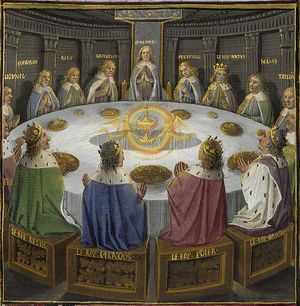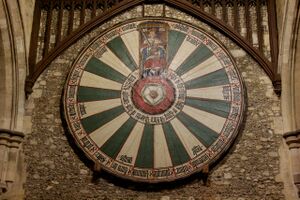Round Table

The romances of King Arthur and his Knights of the Round Table are the reports of the mystery schools of the Brotherhood. According to Celtic legend, the Round Table at Camelot was made by Merlin through his alchemy and given to Uther, father of King Arthur.
The Round Table commemorated the table of Jesus, around which the apostles sat at the Last Supper. The table itself was said to have spiritual powers and could enlarge itself as the number of virtuous knights increased.
Arthurian legend
After passing through other hands, Arthur received the table as a dowry on the occasion of his marriage to his queen, the Lady Guinevere. Thus the foundation of the matrix of every mystery school comes through the hand of the World Mother.
On the occasion of the marriage, the table was blessed by the Archbishop of Canterbury. Merlin then bade the knights to rise and give homage to their king. The focus of king and the role of king is held by the one who is to hold the key to the incarnation of God for that cycle and for that mystery school.
After having given homage to the king, when they arose there appeared upon the table, in letters of gold, the name of each knight—save two. One of these places Merlin called le siège périlleux, “the seat perilous.” No one should occupy it but the most worshipful of knights, the one to achieve the Holy Grail. Anyone else attempting it would be destroyed. The siège périlleux was filled at last by Sir Galahad at the conclusion of the mission of this mystery school.
At the center of the round table there was carved a rose. The rose was the symbol of those troubadours and the bards who came in the middle ages; the symbol that they were of one brotherhood, of one quest, the quest for the mystery of the teachings of the Christ and the mystery of the flame of Christ. And so that mark has appeared again and again as the symbol of the unfoldment of the heart flame of Christ.
There were places for twenty-four knights arranged in twelve pairs and then the double throne for the king and the mysterious unknown knight who would be worthy to sit in the perilous seat.

The rites of the Round Table
The rites of the Round Table descended from the celebration of Pentecost by Joseph of Arimathea at Glastonbury, where he came following the ascension of Jesus. It was therefore ordained by King Arthur that his knights should renew their oaths each year at the high feast of Pentecost.
The knight initiates of the Brotherhood of the Quest performed special religious ceremonies, upheld the vision of the kingdom—that precious community of the Holy Spirit—and lived by a strict moral code, much like a religious order. The jousting and competition of the knights at tournaments was the measuring of the levels of the inner soul attainment on this initiatic ladder, and it was training for the mastery of the soul’s energies in the God control of the energies of the sacred centers of life.
The knights of the quest were dedicated to the defense of the feminine ray. Their ideal was the Cosmic Virgin, whom they would defend in every woman and every lady of the court. They upheld the sanctity of marriage as the Holy Family, commemorating the life of Christ, of Mary and Joseph. They stood for the preservation of truth, of justice throughout the realm. And they guarded the knowledge of the inner truths of the Brotherhood and of the community.
See also
Sources
Elizabeth Clare Prophet, December 31, 1976.
